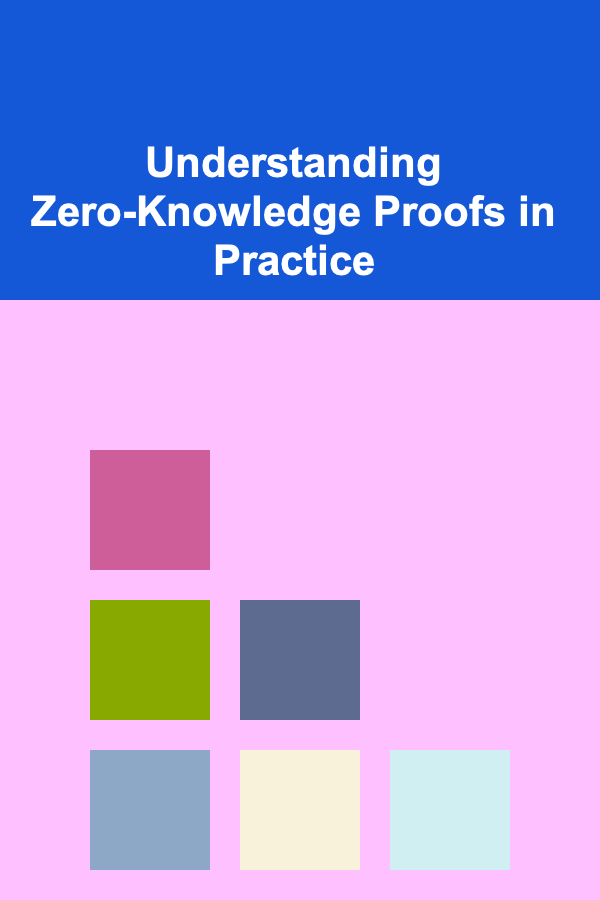
Understanding Zero-Knowledge Proofs in Practice
ebook include PDF & Audio bundle (Micro Guide)
$12.99$5.99
Limited Time Offer! Order within the next:

Zero-knowledge proofs (ZKPs) are a fascinating and powerful cryptographic tool that allows one party (the prover) to convince another party (the verifier) that a statement is true without revealing any information beyond the validity of the statement itself. This seemingly paradoxical capability has profound implications for privacy, security, and trust in a wide range of applications. While the theoretical foundations can be complex, understanding the core principles and practical implementations is crucial for leveraging the potential of ZKPs. This article aims to provide a deep dive into zero-knowledge proofs, focusing on practical understanding and applications.
I. Core Concepts and Intuition
Before delving into practical examples, it's essential to grasp the fundamental properties that define a zero-knowledge proof:
- Completeness: If the statement is true, an honest prover can convince an honest verifier. In other words, the protocol should reliably work when both parties are acting as expected.
- Soundness: If the statement is false, a malicious prover cannot convince an honest verifier (except with a negligible probability). This ensures that the proof carries weight and cannot be faked.
- Zero-Knowledge: The verifier learns nothing other than the fact that the statement is true. This is the core defining property. The verifier gains no information about the secret or witness that the prover is using to support the statement.
The challenge in designing a ZKP protocol lies in achieving all three of these properties simultaneously. Let's consider a classic illustrative example: Where's Waldo?
Imagine Alice wants to prove to Bob that she knows where Waldo is in a "Where's Waldo?" picture without revealing his location. Here's how a simple, although not perfectly zero-knowledge, protocol could work:
- Alice cuts a large square out of cardboard, big enough to completely cover Waldo.
- Alice shows the square to Bob. Bob can only see the area covered by the square.
- Bob says, "Ok, I see Waldo in the square."
This demonstrates completeness: if Alice knows where Waldo is, she can convince Bob. It also demonstrates a degree of soundness: if Alice doesn't know where Waldo is, it's unlikely she could cut a square that happens to contain him.
However, this isn't perfectly zero-knowledge. Bob can still see something about Waldo's location -- namely, the area around him. A better approach would involve using two squares and strategically covering the rest of the picture so that Bob only sees that the squares exist and that one contains Waldo, but nothing else about his specific location.
This intuitive example highlights the core idea: demonstrate knowledge without revealing the knowledge itself. In cryptographic ZKPs, this is achieved using mathematical techniques and protocols.
II. Interactive vs. Non-Interactive Zero-Knowledge Proofs
ZKPs can be categorized into two main types:
- Interactive Zero-Knowledge Proofs (IZKPs): These require multiple rounds of communication between the prover and the verifier. The "Where's Waldo?" example is inherently interactive, as it requires Alice to show the square to Bob and Bob to acknowledge seeing Waldo.
- Non-Interactive Zero-Knowledge Proofs (NIZKPs): These allow the prover to create a proof that can be verified by anyone without requiring any interaction. This is highly desirable for many applications as it simplifies the process and eliminates the need for real-time communication.
The Fiat-Shamir heuristic is a common technique used to transform interactive zero-knowledge proofs into non-interactive ones. It essentially replaces the verifier's random challenges with a hash function applied to the prover's initial commitment. This allows the prover to generate all the necessary messages herself, creating a non-interactive proof.
III. Common Techniques and Protocols
Several cryptographic techniques and protocols are used to construct ZKPs. Here are some of the most important:
A. Sigma Protocols
Sigma protocols are a class of three-move interactive proofs that are often used as building blocks for more complex ZKPs. They typically involve the following steps:
- Commitment: The prover generates a commitment based on their secret and sends it to the verifier.
- Challenge: The verifier sends a random challenge to the prover.
- Response: The prover computes a response based on their secret and the verifier's challenge and sends it back to the verifier.
The verifier then checks the response against the commitment and challenge to determine whether the proof is valid. Many common ZKP constructions are based on Sigma protocols.
A classic example is proving knowledge of a discrete logarithm. Suppose Alice knows x such that y = g^x mod p, where g and p are publicly known. She wants to prove to Bob that she knows x without revealing its value.
- Commitment: Alice chooses a random number
rand computest = g^r mod p. She sendstto Bob. - Challenge: Bob chooses a random challenge
cand sends it to Alice. - Response: Alice computes
s = r + c*x mod (p-1)and sendssto Bob. - Verification: Bob checks if
g^s ≡ t * y^c mod p.
If the verification succeeds, Bob is convinced that Alice knows x. The zero-knowledge property holds because Bob only sees random values and computations based on them. The soundness property holds because if Alice doesn't know x, she cannot compute a valid response for every possible challenge c.
B. zk-SNARKs
zk-SNARKs (Zero-Knowledge Succinct Non-Interactive ARguments of Knowledge) are a powerful type of NIZKP that offers several advantages:
- Zero-Knowledge: They reveal nothing about the secret other than the validity of the statement.
- Succinct: The proof size is very small, typically on the order of a few hundred bytes, regardless of the complexity of the statement being proved.
- Non-Interactive: Verification requires no interaction between the prover and the verifier.
- Arguments of Knowledge: They provide strong guarantees that the prover actually knows the secret being used to generate the proof.
zk-SNARKs work by transforming the statement to be proven into an equivalent arithmetic circuit. This circuit is then compiled into a Quadratic Arithmetic Program (QAP), which can be efficiently evaluated using pairing-based cryptography. The prover computes a proof based on the QAP and their secret, and the verifier checks the proof using a pairing equation.
The complexity of zk-SNARKs makes them difficult to understand at a high level without diving into advanced mathematics. However, it's important to understand their characteristics and use cases.
C. zk-STARKs
zk-STARKs (Zero-Knowledge Scalable Transparent ARguments of Knowledge) are another type of NIZKP that aims to address some of the limitations of zk-SNARKs. The key differences include:
- Transparency: zk-STARKs do not require a trusted setup, which is a critical security concern in zk-SNARKs. The parameters used to generate and verify proofs are publicly verifiable, eliminating the risk of a malicious party compromising the system by controlling the trusted setup.
- Scalability: zk-STARKs offer better scalability for very complex statements compared to zk-SNARKs. The proof size grows logarithmically with the complexity of the statement, making them suitable for proving computations with a large number of steps.
- Post-Quantum Security: zk-STARKs are based on cryptographic primitives that are believed to be resistant to attacks from quantum computers. This makes them a more future-proof solution compared to zk-SNARKs, which rely on pairing-based cryptography that may be vulnerable to quantum attacks.
zk-STARKs rely on different mathematical techniques than zk-SNARKs, primarily using error-correcting codes and fast Fourier transforms. While they offer advantages in terms of transparency and scalability, they often result in larger proof sizes than zk-SNARKs.
D. Bulletproofs
Bulletproofs are a type of ZKP that is particularly well-suited for proving range proofs (e.g., proving that a value lies within a certain interval) and aggregating multiple proofs into a single proof. They offer several advantages:
- No Trusted Setup: Like zk-STARKs, Bulletproofs do not require a trusted setup.
- Efficient Aggregation: Multiple Bulletproofs can be efficiently aggregated into a single proof, reducing the overall proof size and verification time.
- Compact Proof Size: Bulletproofs offer a relatively compact proof size, especially when aggregating multiple proofs.
Bulletproofs are based on inner product arguments and rely on the discrete logarithm assumption for security. They have found applications in privacy-preserving financial systems and other areas where range proofs are required.
IV. Practical Applications of Zero-Knowledge Proofs
The versatility of ZKPs has led to their adoption in a wide range of applications, including:
A. Authentication and Identity Management
ZKPs can be used to authenticate users without revealing their actual credentials. For example, a user could prove that they possess a valid passport without revealing their passport number or other personal information. This can enhance privacy and security in online authentication systems.
Consider proving membership in a group without revealing your identity. Imagine a scenario where access to a certain resource is restricted to members of a particular organization. Using ZKPs, a user could prove that they are a member of the organization without revealing their specific identity or role within the organization. This is extremely valuable for preserving anonymity while still enforcing access control policies.
B. Privacy-Preserving Payments
ZKPs are a key technology behind privacy-focused cryptocurrencies such as Zcash. They allow transactions to be verified without revealing the sender, receiver, or amount transacted. This ensures that financial transactions remain confidential while still maintaining the integrity of the blockchain.
Specifically, zk-SNARKs are used in Zcash to prove that the transaction is valid (i.e., the sender has sufficient funds and the transaction is properly signed) without revealing any information about the transaction parties or amounts. This is a major advancement in financial privacy.
C. Secure Multi-Party Computation (MPC)
ZKPs can be used to verify the correctness of computations performed in secure multi-party computation protocols. MPC allows multiple parties to jointly compute a function on their private inputs without revealing those inputs to each other. ZKPs can be used to ensure that each party is following the protocol correctly and that the final result is accurate.
For example, consider a scenario where multiple hospitals want to calculate the average success rate of a particular surgery without revealing their individual patient data. MPC, combined with ZKPs, can allow them to perform this calculation securely and privately.
D. Verifiable Computation
ZKPs enable verifiable computation, where a computationally weak device can outsource a complex computation to a powerful server and then verify that the server performed the computation correctly. This is particularly useful for resource-constrained devices such as mobile phones and IoT devices.
The server generates a ZKP that proves the correctness of the computation, and the client can efficiently verify the proof without having to re-execute the entire computation. This allows resource-constrained devices to perform complex tasks securely and efficiently.
E. Supply Chain Management
ZKPs can be used to verify the authenticity and provenance of products in a supply chain without revealing sensitive business information. For example, a consumer could verify that a product is genuine and meets certain quality standards without revealing the supplier's proprietary information.
This can help to combat counterfeiting and ensure the integrity of the supply chain. ZKPs can also be used to verify compliance with regulatory requirements without revealing confidential business data.
F. Machine Learning
ZKPs are increasingly being used in the field of machine learning to enable privacy-preserving model training and inference. For example, a machine learning model can be trained on sensitive data without revealing the data itself, or a user can query a machine learning model without revealing their input data.
This is particularly important in applications where data privacy is a major concern, such as healthcare and finance. Federated learning, combined with ZKPs, offers a promising approach to training machine learning models on decentralized data sources while preserving privacy.
V. Practical Considerations and Challenges
While ZKPs offer tremendous potential, there are several practical considerations and challenges that need to be addressed for their widespread adoption:
A. Computational Overhead
Generating and verifying ZKPs can be computationally intensive, especially for complex statements. This can be a bottleneck in performance-critical applications. Optimization techniques are constantly being developed to improve the efficiency of ZKP implementations.
The choice of ZKP scheme (e.g., zk-SNARKs, zk-STARKs, Bulletproofs) depends on the specific application requirements and the trade-offs between proof size, computational overhead, and security assumptions.
B. Complexity of Implementation
Implementing ZKPs requires a deep understanding of cryptography and programming. The complex mathematics involved can make it difficult for developers to build and deploy ZKP-based applications. High-level libraries and frameworks are emerging to simplify the development process, but a solid understanding of the underlying principles is still essential.
C. Security Assumptions
The security of ZKPs relies on certain cryptographic assumptions. It's crucial to carefully evaluate the security assumptions of the chosen ZKP scheme and ensure that they are appropriate for the application. Some ZKP schemes rely on stronger security assumptions than others.
D. Trusted Setup (for some zk-SNARKs)
As mentioned earlier, some zk-SNARK schemes require a trusted setup, which can be a major security concern. If the trusted setup is compromised, the security of the entire system can be at risk. zk-STARKs and Bulletproofs offer an advantage in that they do not require a trusted setup.
E. Standardization
The lack of standardization in ZKP protocols can hinder interoperability and adoption. Efforts are underway to standardize ZKP protocols to facilitate the development of compatible and secure applications.
F. Auditability
Ensuring the auditability of ZKP implementations is crucial for building trust and confidence in the technology. Independent audits can help to identify potential vulnerabilities and ensure that the implementation is secure and correct.
VI. Tools and Libraries
Several tools and libraries are available to help developers work with ZKPs. These include:
- libsnark: A C++ library for zk-SNARKs.
- ZoKrates: A toolbox for zkSNARKs that provides a high-level language for defining computations and a compiler for generating zkSNARK circuits.
- Circom: A circuit compiler and language for designing zero-knowledge circuits, particularly useful for zk-SNARKs.
- bellman: A Rust library for building zk-SNARK circuits.
- halo2: A cutting-edge ZK proof system framework written in Rust.
- StarkWare's Cairo: A programming language for creating STARK-based verifiable programs.
These tools and libraries provide a range of functionalities, from circuit design and compilation to proof generation and verification. They can significantly simplify the development process and make ZKPs more accessible to developers.
VII. The Future of Zero-Knowledge Proofs
Zero-knowledge proofs are a rapidly evolving field with tremendous potential to transform various industries. As the technology matures and becomes more accessible, we can expect to see even wider adoption of ZKPs in the coming years.
Key areas of future development include:
- Improved Efficiency: Continued research and development efforts will focus on improving the efficiency of ZKP algorithms and implementations.
- Simplified Development Tools: The development of more user-friendly tools and libraries will make ZKPs more accessible to developers with varying levels of expertise.
- Standardization: Efforts to standardize ZKP protocols will facilitate interoperability and adoption.
- New Applications: ZKPs will continue to find new applications in areas such as decentralized finance (DeFi), data privacy, and verifiable AI.
- Integration with Blockchain: ZKPs will play an increasingly important role in scaling and enhancing the privacy of blockchain systems.
VIII. Conclusion
Zero-knowledge proofs are a revolutionary cryptographic tool that allows one party to prove the truth of a statement to another party without revealing any additional information. While the underlying mathematics can be complex, the core concepts are relatively straightforward and can be understood through practical examples.
The versatility of ZKPs has led to their adoption in a wide range of applications, including authentication, privacy-preserving payments, secure multi-party computation, verifiable computation, supply chain management, and machine learning. As the technology matures and becomes more accessible, we can expect to see even wider adoption of ZKPs in the future.
Understanding the principles and practical considerations of ZKPs is crucial for anyone interested in leveraging their potential to build more secure, private, and trustworthy systems. The challenges are significant, but the potential rewards are enormous.

Affordable and Enjoyable Low-Cost Hobbies and Activities for Any Budget
Read More
How to Train Your Brain to Manage Anxiety
Read More
How to Use Color Coordination for Seasonal Clothing
Read More
How to Use Tui Na Massage for Therapeutic Benefits
Read More
Mastering Environmental Consulting: Best Practices for Impactful Projects
Read More
10 Tips for Using a Project Management Checklist to Reduce Risk
Read MoreOther Products

Affordable and Enjoyable Low-Cost Hobbies and Activities for Any Budget
Read More
How to Train Your Brain to Manage Anxiety
Read More
How to Use Color Coordination for Seasonal Clothing
Read More
How to Use Tui Na Massage for Therapeutic Benefits
Read More
Mastering Environmental Consulting: Best Practices for Impactful Projects
Read More